Marie Law Adams, MArch ’06
When most people see urban industrial sites, such as sand and salt piles or neglected land under highway overpasses, they don’t think of them as opportunities to serve the local community. However, Marie Law Adams sees endless possibilities in those spaces. She and her husband, Dan Adams, founded Landing Studio in 2005 to work on sustainable rehabilitation of those underutilized sites for public use.
Architects don’t typically design for spaces like that, but they should, she says: “We work fairly closely with MassDOT to figure out what their maintenance and operation requirements are and look for ways to choreograph those in relation to public access.”
One of their biggest ongoing projects has involved an industrial road-salt facility in Chelsea, Massachusetts. The space, which is filled with salt during the winter, has been transformed so that when the salt is gone, it becomes a public recreation site. The park was completed in 2014.

“There are places along Boston Harbor where you get dense residential areas, like in Chelsea, and then also really heavily industrial areas,” says Adams. “For a lot of years, those were always very contentious relationships between the local neighborhoods and the sites of global industry. We do a lot of work to figure out how to productively design the relationship between those industrial sites and local urban context.”
Adams is also working on repurposing underutilized space beneath an elevated stretch of Interstate 93 where the South End and South Boston meet. The design for the space, which has ample natural light and water, includes a maintenance access area and landscape features that support integrated stormwater management. The site will also include basketball courts, dog parks, and other recreational spaces.
“At Landing Studio, we often find that our work is not always the design of buildings but often industrial operations—seeing how trucks move through an environment and how that creates different kinds of landscape conditions,” she says. “And a lot of the sites we work with change over the course of the year.”
Adams’s studio was a winner of the 2015 Architectural League Prize and one of the winners of the Design Biennial Boston in 2015, which included an installation titled Marginal on the Rose Kennedy Greenway, a re-created wharf made of material salvaged from Boston Harbor.
Adams and her husband live in Cambridge with their two cats and enjoy running.
Keep Reading
Most Popular
Large language models can do jaw-dropping things. But nobody knows exactly why.
And that's a problem. Figuring it out is one of the biggest scientific puzzles of our time and a crucial step towards controlling more powerful future models.
How scientists traced a mysterious covid case back to six toilets
When wastewater surveillance turns into a hunt for a single infected individual, the ethics get tricky.
The problem with plug-in hybrids? Their drivers.
Plug-in hybrids are often sold as a transition to EVs, but new data from Europe shows we’re still underestimating the emissions they produce.
Google DeepMind’s new generative model makes Super Mario–like games from scratch
Genie learns how to control games by watching hours and hours of video. It could help train next-gen robots too.
Stay connected
Get the latest updates from
MIT Technology Review
Discover special offers, top stories, upcoming events, and more.